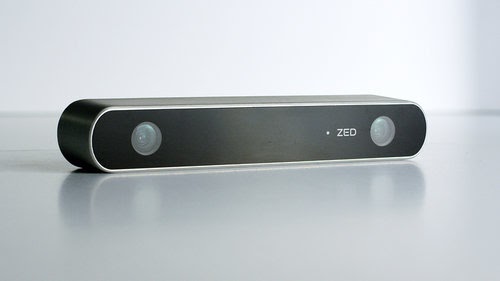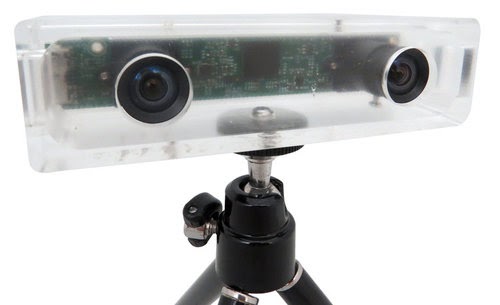Leo Rover Blog – Affordable 3D cameras for ROS developers
We’ve gathered a list of camera-based sensors that are easy to get and affordable.
Mục Lục
Most of the time, when robot developers talk about SLAM, they address localization and mapping with the use of Lidar and stereo-vision cameras. In this article, we’ll focus on the latter.
We didn’t name the article ‘stereo vision cameras for your rovers’ on purpose as there are at least three different approaches to the problem of vision-based depth mapping: stereo vision cameras, time-of-flight sensors and structured light cameras. With those readings on board, your rover can calculate its position in 3-dimensional workspace knowing not only what obstacles look like, but also how far and how big they are.
Let’s just quickly go through differences between the three approaches and then, we’ll list different off-the-shelf components that are easy to implement to your ROS-based rovers.

Stereo vision
Stereo vision is the most intuitive concept to understand. It mimics the natural vision perception of humans and many other species. Stereo vision camera is essentially a camera that consists of two sensors (two lenses) located at a certain distance from one another. It relies on a difference between the left and right camera images which will be slightly shifted depending on the distance to the object it is looking at. Although the measurement relies on a high-demanding calculation of the images differences, the stereo-vision cameras tend to be the least sensitive to the object material, background or different light conditions and are great to be used for outdoor localization and mapping.
Structured light
As typically the object you’re looking at is unknown, the biggest issue with stereo vision cameras is that you need to rely on image processing of the object contours and distinctive points to take into the depth calculation. It takes a lot of computational power – just like in nature. On the other hand, the structured light approach relies on projecting a mesh (most commonly infrared light) to the object and looking for a difference between what it should look like and what it looks like in reality. The bigger the mesh cells, the closer the object is, and as the mesh curves on the object surface, we can tell what shape it is as well. Knowing what to look for, we can calculate with less computing power. On the other hand, though, as we rely on projected light reflection, we can’t always be sure how the object’s surface and background light affected the reading.
Time-of-flight
This kind of cameras are widely used in photography and phone cameras. Time-of-flight cameras and sensors rely on a time delay between artificial light release and capture of the light being reflected by an object. As light needs a certain time to travel, the time-of-flight system can calculate distance between camera and the object relying on constant light speed and the delay parameter. The procedure is similar to LiDAR readings, but as the hardware and application are closer to cameras than laser sensors, time-of-flight cameras belong to the list here.
The list of camera-based sensors for your rover
The list is the result of our market research and, hopefully, will be enough for you to choose from. We selected the cameras based on their availability and price and evaded the ones that are so specialized that cost a small fortune to get. For sure you’ll find more interesting cameras on the market, but here we’ll focus on the ones you can actually get and work with.
Stereo-vision cameras

Price: $349 – $449
Type: Embedded stereo
Depth Range: 0.3 to 25 m
FOV: 96° H, 54° V
Physical Dimensions: 175x30x33 mm
Interface: USB 3.0
Link to ROS Driver

Price: $349
Type: Embedded Stereo Camera
FOV: 60° H
Physical Dimensions: 100x30x35 mm
Interface: USB 3.0
Link to ROS Driver
Notes: Inbuilt IMU

Price: $199
Type: Stereo camera with tracking hardware and software
Cameras: Two Fisheye lenses with combined 163±5° FOV
Physical Dimensions: 108 mm x 24.5 mm x 12.5 mm
Interface: USB 3.1 Gen 1 Micro B (USB2.0 supported)
Link to ROS Driver
Notes: Integrates wheel odometry

Price: $595-$695
Type: Stereo Camera
Depth Range: 0.23 m to 2.5 m for for M series
FOV: 170 W with 30 mm Baseline
Physical Dimensions: 57 x 30.5 x 14.7mm
Interface: 480 Mbps USB 2.0 Micro-B
Link to API
Link to ROS Driver
Notes: Pixel size 6 x 6 micrometers. Shutter Speed 0.3 microseconds to 1- seconds. Control Functions: Exposure, Shutter, Brightness. Enclosure 6021 Aircraft Grade Aluminium.

Price: $239-$399
Type: Stereo Camera
Depth Range: 0.5 to 18 m
FOV: 146° D, 122° H, 76° V
Physical Dimensions: 141.9 x 61.5 x 68.4 mm
Interface: USB 3.0
Link to SDK
Notes:Six Axis IMU, 100/200/250/333/500 hz Frequency, IMU&Frame Sync: <1ms
Time-of-flight cameras

Microsoft® Kinect™ 2.0
Price: aftermarket – $50-$300
Type: Time of flight
Depth Range: 0.5 to 4.5 m
FOV: 70° H, 60° V
Physical dimensions: ~250x70x45 mm (head)
Interface: USB 3.0
Link to ROS Driver
Structured light cameras

ASUS® XtionPro™ Live
Price: aftermarket
Type: Structured light
Depth Range: 0.8 to 3.5 m
FOV: 58° H, 45° V
Physical dimensions: ~180x40x25 mm (head)
Interface: USB 2.0
Link to ROS Driver
Notes: Similar internals to the Xbox Kinect 1.0. Discontinued.

Price: $79 – $199
Type: Active IR Stereo
Depth Range: 0.105 to 10 m /0.3 to 10 m
Depth FOV: 63.4° x 40.4° (+/-3°)
RGB FOB: 69.4° x 42.5° x 77° (+/- 3°)
Physical Dimensions: 99 mm x 20 mm x 23 mm
Interface: USB-C 3.1 Gen 1
Link to ROS Driver

Price: $149.99
Type: Structured Light
Depth Range: 0.6 m to 5.0 m
FOV: 73 D x 60 H x 49.5 V
Physical Dimensions: 80 x 20 x 20 mm
Interface: <2.4w data-preserve-html-node=”true” USB
Link to ROS Driver















![Toni Kroos là ai? [ sự thật về tiểu sử đầy đủ Toni Kroos ]](https://evbn.org/wp-content/uploads/New-Project-6635-1671934592.jpg)


